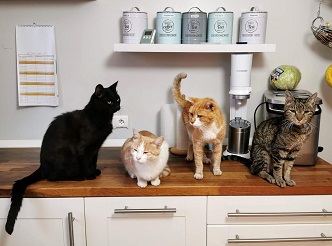Cats, often celebrated for their independent nature, are also social beings that thrive on connections and interactions. While they might have a reputation for solitude, fostering social bonds among cats is vital for their overall well-being.
Cat caves, seemingly solitary spaces, hold the potential to become catalysts for promoting feline socialization.

Methods
This article delves into the intriguing dynamics of how cat caves can play a pivotal role in bringing cats together, facilitating social engagement, and nurturing harmonious relationships.
We will talk about how cat caves foster feline socialization in 9 aspects. If you want to know more, you can read on.
1. The Social Side of Cats
Contrary to the view of solitary behavior, cats form intricate social structures in both domestic and feral settings. They engage in behaviors like mutual grooming, play, and even communal sleeping.
This underlines their need for companionship and interaction, which cat owners can facilitate through strategic interventions.
2. Cat Caves as Shared Spaces
Cat caves, often perceived as solitary hideaways, can serve as communal hubs if placed and designed thoughtfully. The inclusion of multi-level caves with interconnected passages can create a cozy environment that invites multiple cats to coexist and interact comfortably.
3. Encouraging Cooperative Play
Cat caves equipped with interactive toys and dangling accessories encourage cooperative play. When cats engage in play together within the confines of a cave, they establish positive associations with each other’s presence, gradually fostering companionship and camaraderie.
4. Creating Secure Social Zones
Social interaction can be daunting for some cats, particularly those that are more timid. Cat caves provide a secure environment where shy or introverted cats can engage with others without feeling threatened.
The cave’s enclosed nature offers a safe space to gradually build social confidence.
5. Facilitating Positive Associations
Cat caves can be associated with pleasant experiences, such as treats or toys, during group interactions. This process reinforces positive emotions towards each other and the shared space.
Over time, cats start associating the cave with enjoyment and may seek it out for social interactions.
6. Bonding Through Mutual Grooming
Cats engage in mutual grooming not only for hygiene but also to strengthen social bonds. Placing a cat cave in proximity to a window or a sunny spot can encourage cats to groom each other, fostering emotional connections.
7. Managing Multi-Cat Dynamics
In households with multiple cats, cat caves offer a strategic solution for avoiding conflicts. Placing multiple caves throughout the home gives each cat a personal retreat while still allowing them to engage socially when they feel comfortable.
8. Fostering a Sense of Unity
By introducing cats to a shared space like a cat cave, owners create opportunities for them to develop a sense of unity and familiarity. As cats associate positive experiences and interactions with the cave, it becomes a cornerstone of their social interactions.
9. The Beauty of Feline Connections
Cat caves, initially viewed as personal retreats, metamorphose into symbolic bridges that unite cats. By promoting socialization and encouraging harmonious relationships, they highlight the profound impact of positive feline interactions on their mental and emotional well-being.

Conclusion
In the heart of a seemingly solitary cat cave lies the potential to ignite and nurture social connections among feline companions. By thoughtfully integrating cat caves into our homes, we pave the way for enriching the lives of our beloved cats through bonds that go beyond the superficial.
As we recognize the significance of fostering socialization, we create a tapestry of relationships that adds depth, joy, and meaning to the lives of our feline friends.
 Armand
Armand